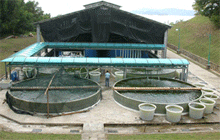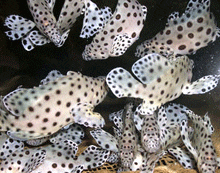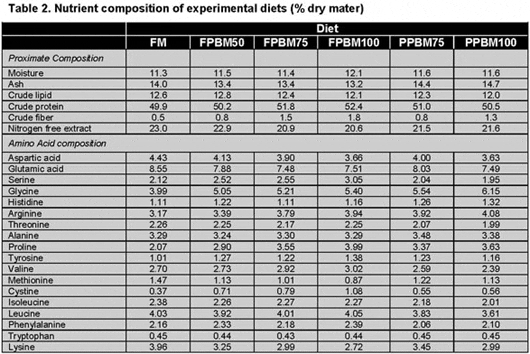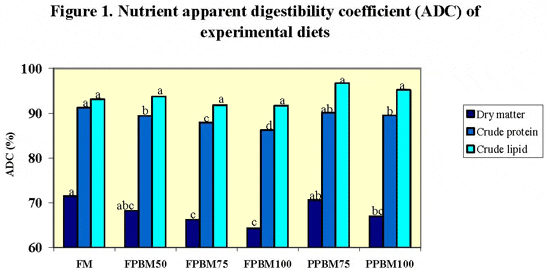The demand for trash fish is increasing steadily despite decreasing prey fish stocks in the world’s oceans and competing use for human consumption (Tacon et al., 2006). In order to sustain the rapidly expanding marine fish farming industry in Southeast Asia, more farmers are using commercial formulated feeds in the aquaculture of captive groupers. Currently available commercial feeds for tropical marine carnivorous fish are based on fish meal as the main dietary protein source. Total global fish meal production has remained relatively static over the past quarter century. This limited supply coupled with increasing demand for fish meal has greatly inflated the cost of this commodity.
Therefore, finding suitable protein sources as alternatives to fish meal is critical in the commercial culture of carnivorous fish species, especially for fish such as the humpback grouper, Cromileptes altivelis, which require high protein (about 50%) in their diets (Williams et al. 2004). Groupers, especially slower growing species such as the humpback grouper, are highly valued fish, priced for their excellent meat quality and taste in the regional live fish trade. One potential fish meal alternative is poultry by-product meals (PBM) which are rendered by-products from the poultry processing industry.

Photo: NACA
PBM are produced in many parts of the world, including the Southeast Asia region which accounts for approximately one-quarter of the global poultry trade (FAO, 2004). It has high potential to be incorporated in the diet of carnivorous fish species such as groupers due to its high protein content and lower price compared to fish meal. In addition, studies on the apparent digestibility of PBM revealed that this product is well-digested by several fish species (Bureau et al., 1999). Back in 1980s -1990s, PBM was only able to replace fish meal in fish diets at a level not exceeding 50%. Tremendous improvement has been achieved in recent years when PBM was reported to be able to replace fish meal at higher levels of up to 100% (Nengas et al., 1999; Takagi et al., 2000; Gaylord and Rawles, 2005). The improved performance of PBM was mainly due to the improved quality of the product through the use of more advanced processing technology. We recently conducted a feeding trial using PBM of two origins (local vs. imported) and grades (feed vs. pet food) in the diets of humpback grouper at graded levels and compared with a fish meal-based diet (control diet) for the effects on growth, feed efficiency, body composition and nutrient digestibility.
Materials and methods

Photo: NACA
Six experimental diets were formulated to replace fish meal with PBM. Diet 1 (FM) was the control diet with Danish fish meal as the only protein source. Diets 2-4 were formulated to replace fish meal with a locally sourced feed-grade PBM (Dindings Soya & Multifeeds Ltd., Malaysia) at 50% (FPBM50), 75% (FPBM750) or 100% (FPBM100), respectively. In Diets 5 and 6, 75% (PPBM75) and 100% (PPBM100) of fish meal, respectively, were replaced by an imported pet food grade PBM [National Renderers Association (NRA), USA]. Chromic oxide (1%) was added to determine the apparent digestibility coefficient (ADC) of the diets. Humpback grouper fingerlings of mean initial body weight 12.41 ± 0.24 g were randomly distributed into groups of 15 fish in cylindrical cages (61 cm depth and 43 cm diameter; total of 18 cages), and placed in a 150-ton seawater poly-ethylene tank, supplied with aeration. The experimental diets were fed close to apparent satiation twice a day to triplicate groups of fish. The feeding trial was conducted for eight weeks. Upon completion of the feeding trial, remaining fish from the same treatments were pooled, divided into duplicate sets and transferred into 12 fiberglass tanks (300L) with a flow-through system. After one week acclimatization in the new culture system, feces were collected by carefully siphoning the tank bottom for diet digestibility determination.

Results and discussion
Good growth and survival rates of humpback grouper fingerlings were observed. Except for diet FPBM100 (replacement with 100% local PBM), all PBM-based diets performed as well as the control diet (Table 1). Feed conversion ratio (FCR) ranged from 1.1 to 1.5. No significant difference was detected in the total feed intake of fish fed the various experimental diets (P>0.05). The results demonstrated that a significant amount of fish meal can be replaced with PBM in the diet of humpback grouper without adverse effects on growth performance and feed utilization. In view of the high protein requirement of humpback groupers, the use of PBM will contribute significantly to cost-savings. In addition, humpback groupers are slow-growing species, which takes a longer time to reach marketable size compared with other grouper species. This longer culture period implies a higher requirement for feed input and cost of maintenance. Therefore, feed costs can be substantially reduced with the inclusion of greater quantities of PBM in the diets of humpback grouper and possibly in the diets of other tropical marine carnivorous cultured fish species.
The amino acid composition of the PBM used was within the published values for this ingredient, and it influenced the overall amino acid composition of the experimental diets (Table 2). It was interesting to note that the cystine concentration in FPBM was about double that found in PPBM but the sparing value of cystine for methionine in grouper is currently not known. Both methionine and lysine appeared to be the limiting amino acids in the experimental diets with 100% PBM. The methionine concentration was 0.87 % in FPBM100 diet and ranged from 1.01 – 1.47 % in the other experimental diets. This might have contributed in part to the poor growth of fish fed diet FPBM100. Longer-termed feeding trials will be required to determine if a dietary methionine level of below 1% can support the normal growth of humpback grouper fingerlings. The quantitative lysine requirement for humpback grouper is currently not known. Compared to the control diet, the FPBM100 diet had markedly lower lysine content which was the lowest concentration among all the PBM-based diets.

The dry matter and protein ADC for the FPBM100 diet were the lowest among the various diets (Figure 1). This was probably the major contributing factor to the poor growth performance of humpback grouper fingerling fed this diet. High lipid ADC values were observed in all dietary treatments (91.7 – 96.7 %), and these values were not significantly different among dietary treatments. The better nutrient digestibility of the PPBM compared to FPBM allowed higher dietary levels of this ingredient to be included without noticeable growth depression. In conclusion, terrestrial PBM can successfully replace more than half of the protein from marine fish meal in the formulated diets for the humpback grouper, a marine carnivorous tropical fish. However, the use of PBM as the sole protein source in the diets of humpback grouper might be constrained by lowered nutrient digestibility and limiting essential amino acids, especially methionine and lysine. Further research with longer-term feeding trials is currently being carried out to evaluate the nutritive value of PBM for marine fish species.

The full results of this project were published in:
Shapawi, R., Ng, W.K., & Mustafa, S., 2007. Replacement of fish meal with poultry by-product meal in diets formulated for the humpback grouper, Cromileptes altivelis. Aquaculture 273, 118-126.
References
- Bureau, D.P., Harris, A.M., Cho, C.Y., 1999. Apparent digestibility of rendered animal protein ingredients for rainbow trout. Aquaculture 180: 345-358.
FAO, 2004. EMPRES Transboundary Animal Diseases Bulletin No 25, January-June 2004. - Gaylord, T.G. and Rawles, S.D., 2005. The modification of poultry by-product meal for use in hybrid striped bass Morone chrysops x M. saxatilis diets. J. World Aquacult. Soc. 36: 365-376.
- Nengas, I., Alexis, M.N., Davis, S.J. 1999. High Inclusion levels of poultry meals and related by products in diets for gilthead seabream, Sparus aurata L. Aquaculture 179: 12-23.
- Tacon, A.G.J., Hassan, M.R., Subasinghe, R.P., 2006. Use of fishery resources as feed inputs to aquaculture development: trends and policy implications. FAO Fisheries Circular No. 1018. FAO. Italy, Rome, 99 pp.
- Takagi, S.T., Hosokawa, H., Shimeno, S., Ukawa, M., 2000. Utilization of poultry by-product meal in a diet for red sea bream Pagrus major. Nippon Suisan Gakkaishi 66: 428-438.
- Williams, K.C., Irvin S., Barclay, M., 2004. Polka dot grouper Cromileptes altivelis juvenile require high protein and moderate lipid diets for optimal growth and nutrient retention. Aquacult. Nutr. 10: 125-134.
October 2008

